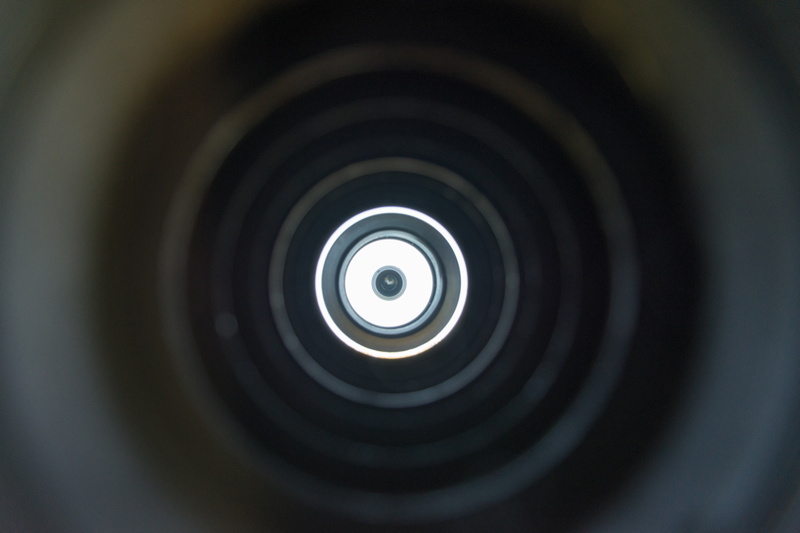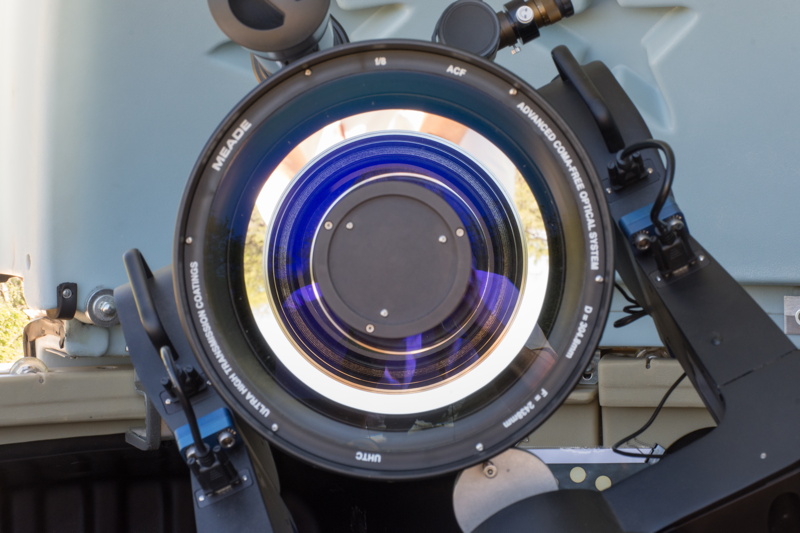LX600 Collimation:
Significant improvement on a windy night
Posted: 26 May 2016
As I mentioned on the last report, Dr. Clay Sherrod gave me some tests to try during the daytime. He wanted me to view the sky through the back of the telescope and see if the rings of light and dark were concentric. They weren't. He also wanted a check through the front of the telescope; the rings were not concentric there either. These photos show what I was seeing:


I sent the photos to Dr. Clay for his evaluation. He asked me to do a daylight collimation by turning the collimation screws while watching the mirror reflections from the aperture end. I did that and seemed to have improved things:

Would have to wait until night to check for any real improvement.
|
Open: Wednesday, 25 May 2016, 1832 MST Temperature: 84°F |
Session: 969 Conditions: Clear, windy |
Equipment Used:
12" f/8 LX600 w/StarLock
Wireless AutoStar II handset
2" 24mm UWA eyepiece
2" 9mm 100° eyepiece
2" 2X PowerMate
Camera:
D7200 DSLR
Upon arrival at the observatory I opened the dome to let the telescope begin cooling down to ambient temperature for the night's collimation work. Normally I would not have even been in the observatory since it was so windy, but I wanted to at least check on how well the daylight collimation was.
1925 MST: sunset. Still windy. Checked the wind forecast; not good for the night.
1934 MST: LX600 ON, StarLock OFF. Viewed Jupiter, 102X. The view was the worse I've ever seen in a telescope! I could not even achieve a focus on Jupiter.
Slewed to the star Spica. It was obvious that the collimation was way off, although the daylight collimation had given me a known starting point. Mounted the D7200 DSLR at prime focus + 2X PowerMate to image the Fresnel pattern for Dr. Clay. This full-frame image, 1/30sec, ISO 3200, shows how bad the collimation was:

Using the Nikon iOS app "WMU" I downloaded the DSLR image onto my iPhone via the camera's Wi-Fi connection. I then emailed the image to Dr. Clay. Within a few minutes I received a response with a request to try to get closer to being in collimation.
Rather than switch to using an eyepiece to do try to improve the collimation I decided to stick with the camera and view the Fresnel pattern on the DSLR live view screen. I could magnify that view on the camera while keeping the degree of out-of-focus manageable. The initial screw rotation was pretty large to move the central hole closer to the center of the Fresnel pattern, but later ones were much smaller. I was able to get closer to a good collimation, as seen in this full-frame, 1/30sec, ISO 3200, exposure:

I then removed the camera and viewed Jupiter, 271X. Whew, best view of the planet and moons since before I started trying to correct the collimation several nights ago! There was only a very slight elongation of the moons and the planet appeared pretty sharp. I then viewed Mars, 271X. It was still too low in the southeast for good steady viewing (and the wind didn't help), but the planet looked pretty good. It was obvious that I had made a significant improvement in the collimation of the 12" LX600 telescope. And thanks to the assistance of Dr. Clay, I now have my confidence back.
Due to the windy conditions I decided to not try to make the collimation perfect this session. Weather permitting I will do that on the next night.
|
Close: Wednesday, 25 May 2016, 2112 MST Temperature: 64°F |
Session Length: 2h 40m Conditions: Clear, windy |
Comments are welcome using Email. Twitter users can use the button below to tweet this report to your followers. Thanks.
Cassiopeia Observatory Home Page
Copyright ©2016 Michael L. Weasner / mweasner@me.com
URL = http://www.weasner.com/co/Reports/2016/05/26/index.html
